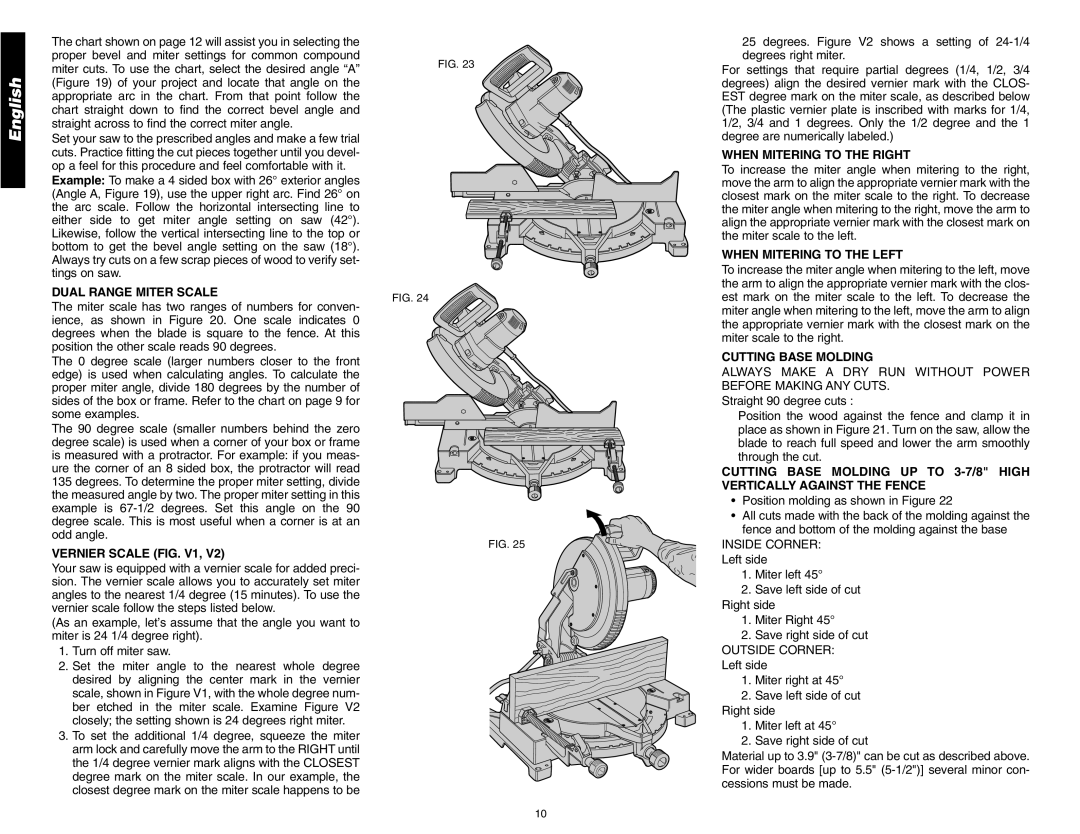
English
The chart shown on page 12 will assist you in selecting the proper bevel and miter settings for common compound
miter cuts. To use the chart, select the desired angle “A” | FIG. 23 |
| |
(Figure 19) of your project and locate that angle on the |
|
appropriate arc in the chart. From that point follow the |
|
chart straight down to find the correct bevel angle and |
|
straight across to find the correct miter angle. |
|
Set your saw to the prescribed angles and make a few trial |
|
cuts. Practice fitting the cut pieces together until you devel- |
|
op a feel for this procedure and feel comfortable with it. |
|
Example: To make a 4 sided box with 26° exterior angles |
|
(Angle A, Figure 19), use the upper right arc. Find 26° on |
|
the arc scale. Follow the horizontal intersecting line to |
|
either side to get miter angle setting on saw (42°). |
|
Likewise, follow the vertical intersecting line to the top or |
|
bottom to get the bevel angle setting on the saw (18°). |
|
Always try cuts on a few scrap pieces of wood to verify set- |
|
tings on saw. |
|
DUAL RANGE MITER SCALE | FIG. 24 |
|
The miter scale has two ranges of numbers for conven- ience, as shown in Figure 20. One scale indicates 0 degrees when the blade is square to the fence. At this position the other scale reads 90 degrees.
The 0 degree scale (larger numbers closer to the front edge) is used when calculating angles. To calculate the proper miter angle, divide 180 degrees by the number of sides of the box or frame. Refer to the chart on page 9 for some examples.
The 90 degree scale (smaller numbers behind the zero degree scale) is used when a corner of your box or frame is measured with a protractor. For example: if you meas- ure the corner of an 8 sided box, the protractor will read 135 degrees. To determine the proper miter setting, divide the measured angle by two. The proper miter setting in this example is
VERNIER SCALE (FIG. V1, V2)
Your saw is equipped with a vernier scale for added preci- sion. The vernier scale allows you to accurately set miter angles to the nearest 1/4 degree (15 minutes). To use the vernier scale follow the steps listed below.
(As an example, let’s assume that the angle you want to miter is 24 1/4 degree right).
1.Turn off miter saw.
2.Set the miter angle to the nearest whole degree desired by aligning the center mark in the vernier scale, shown in Figure V1, with the whole degree num- ber etched in the miter scale. Examine Figure V2 closely; the setting shown is 24 degrees right miter.
3.To set the additional 1/4 degree, squeeze the miter arm lock and carefully move the arm to the RIGHT until the 1/4 degree vernier mark aligns with the CLOSEST degree mark on the miter scale. In our example, the closest degree mark on the miter scale happens to be
FIG. 25
F
U
A
R
25 degrees. Figure V2 shows a setting of
For settings that require partial degrees (1/4, 1/2, 3/4 degrees) align the desired vernier mark with the CLOS- EST degree mark on the miter scale, as described below (The plastic vernier plate is inscribed with marks for 1/4, 1/2, 3/4 and 1 degrees. Only the 1/2 degree and the 1 degree are numerically labeled.)
WHEN MITERING TO THE RIGHT
To increase the miter angle when mitering to the right, move the arm to align the appropriate vernier mark with the closest mark on the miter scale to the right. To decrease the miter angle when mitering to the right, move the arm to align the appropriate vernier mark with the closest mark on the miter scale to the left.
WHEN MITERING TO THE LEFT
To increase the miter angle when mitering to the left, move the arm to align the appropriate vernier mark with the clos- est mark on the miter scale to the left. To decrease the miter angle when mitering to the left, move the arm to align the appropriate vernier mark with the closest mark on the miter scale to the right.
CUTTING BASE MOLDING
ALWAYS MAKE A DRY RUN WITHOUT POWER BEFORE MAKING ANY CUTS.
Straight 90 degree cuts :
Position the wood against the fence and clamp it in place as shown in Figure 21. Turn on the saw, allow the blade to reach full speed and lower the arm smoothly through the cut.
CUTTING BASE MOLDING UP TO
•Position molding as shown in Figure 22
•All cuts made with the back of the molding against the fence and bottom of the molding against the base
INSIDE CORNER:
Left side
1.Miter left 45°
2.Save left side of cut Right side
1.Miter Right 45°
2.Save right side of cut
OUTSIDE CORNER: Left side
1.Miter right at 45°
2.Save left side of cut Right side
1.Miter left at 45°
2.Save right side of cut
Material up to 3.9"
10
